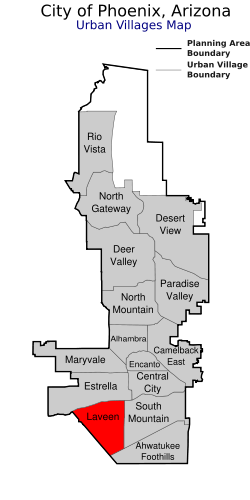Laveen, Arizona
| Laveen | |
|---|---|
| Urban village | |
| Laveen Village | |

The Laveen Village welcoming Water Tower
|
|
| Motto: Where rural is a way of life | |
 Location of Laveen highlighted in red. |
|
| Country | United States |
| State | Arizona |
| County | Maricopa |
| City | Phoenix |
| Website | Laveen Village Planning Committee |
| Laveen, Arizona | |
|---|---|
| Census-designated place (CDP) | |
 Location of Laveen in Maricopa County, Arizona. |
|
| Coordinates: 33°22′39.14″N 112°10′5.81″W / 33.3775389°N 112.1682806°WCoordinates: 33°22′39.14″N 112°10′5.81″W / 33.3775389°N 112.1682806°W | |
| Country | United States |
| State | Arizona |
| County | Maricopa |
| Area | |
| • Total | 48 sq mi (124.3 km2) |
| Elevation | 1,033 ft (315 m) |
| Population (2000) | |
| • Total | 48,021 |
| • Density | 123.5/sq mi (47.7/km2) |
| Time zone | Mountain (MST) (UTC-7) |
| ZIP codes | 85339 and 85041 |
| Area code(s) | 602, 623 |
| GNIS feature ID | 6920 |
Laveen /ləˈviːn/ is an "urban village" within the city of Phoenix in Maricopa County, Arizona, United States, situated eight miles (13 km) southwest of Downtown Phoenix between South Mountain and the confluence of the Gila and Salt rivers. Parts of Laveen constitute an unincorporated community in Maricopa County, while the remainder falls within the city limits of Phoenix, constituting the city's "Laveen Village". Laveen Village is split between District 7 and District 8, both notable as minority-majority districts for the city. Although Laveen has been home to "pastoral alfalfa, cotton, and dairy farms" since the 1880s, housing and commercial developments have been increasingly urbanizing the area.
The Laveen area was first settled by farmers and dairymen in 1884. Despite its proximity to Phoenix, the community was isolated from its larger neighbor by the Salt River, which until the Roosevelt Dam was completed in 1911 carried water year-round. The only bridged crossing was at Central Avenue, more than six miles (10 km) away. Because of its isolation, like the rest of south Phoenix early Laveen was autonomous of Phoenix and became relatively self-sufficient, supporting two general stores, a barbershop, repair garage, two pool halls, and a building for the Laveen Women's Club. These businesses served as important gathering places for the greater Laveen community, which includes modern south Phoenix and the neighboring Gila River Indian Community (GRIC)
...
Wikipedia
